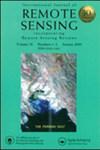Identifying morphological hotspots in large rivers by optimizing image enhancement
IF 1.5
4区 地球科学
Q3 IMAGING SCIENCE & PHOTOGRAPHIC TECHNOLOGY
引用次数: 0
Abstract
ABSTRACTLimited access to observe in-situ sediment changes requires viable means for quantifying sediment transport in large rivers for effective management of changes in river channels. This study developed a remote sensing-based framework to identify erosion hotspots by magnifying sediment concentration from Sentinel-2 and Landsat-8/9 multispectral images of the Brahmaputra River and the Indus River. First, uncorrelated independent bands were produced to boost the spectral information using the Principal Component Analysis (PCA). The optimal band composite was then identified by applying the Optimum Index Factor (OIF) on the Principal Components (PCs). This approach determined a 3-PCs composite having the highest variance with the least correlation to highlight active morphological changes during flood times. The results of the study reaffirm the significance of the minor PCs (PC4, PC5 and PC6) to characterize the small variation in the data, whereas the main PCs depict the majority of the brightness values around means. The approach was applied to Sentinel-2 imagery acquired on September 2018 in the Brahmaputra River, and Landsat-8/9 images of 2015 and 2022 in the Indus River during flood time to enhance and identify active riverbank erosion hotspots. Precise and timely monitoring of erosion-prone areas can support the control of riverbank erosion and improve soil conservation practices. AcknowledgmentsThe authors are grateful for the contributions of Prof. Dr Atsuhiro Yorozuya, Mr Hiroshi Koseki, Prof. Dr Shoji Okada and Dr Tanjir Ahmed for the turbidity measurements carried out in the Brahmaputra River in 2018 which have been used in this study. This research was supported in part by a grant (University Research Projects Grants F.Y. 2021-22, 2022-23) from the University of the Punjab, Lahore, Pakistan.Disclosure statementNo potential conflict of interest was reported by the author(s).基于优化图像增强的大型河流形态热点识别
【摘要】由于对原位泥沙变化的观测途径有限,需要有可行的方法来量化大河的输沙量,从而有效地管理河道的变化。本研究开发了一个基于遥感的框架,通过放大布拉马普特拉河和印度河的Sentinel-2和Landsat-8/9多光谱图像的沉积物浓度来识别侵蚀热点。首先,利用主成分分析(PCA)产生不相关的独立波段来增强光谱信息;然后通过对主成分(PCs)应用最优指数因子(OIF)来确定最佳波段组合。该方法确定了具有最高方差和最小相关性的3- pc复合,以突出洪水期间的活跃形态变化。研究结果重申了次要pc (PC4、PC5和PC6)在描述数据的小变化方面的重要性,而主要pc则描述了平均值附近的大部分亮度值。将该方法应用于2018年9月在雅鲁藏布江获得的Sentinel-2图像,以及2015年和2022年在印度河洪水期间获得的Landsat-8/9图像,以增强和识别活跃的河岸侵蚀热点。对易受侵蚀地区进行精确、及时的监测,有助于控制河岸侵蚀,改进水土保持措施。作者感谢Atsuhiro Yorozuya教授、Hiroshi Koseki先生、Shoji Okada教授和Tanjir Ahmed博士为2018年在雅鲁藏布江进行的浊度测量所做的贡献,这些测量已用于本研究。这项研究得到了巴基斯坦拉合尔旁遮普邦大学的部分资助(大学研究项目资助基金2021- 22,2022 -23)。披露声明作者未报告潜在的利益冲突。
本文章由计算机程序翻译,如有差异,请以英文原文为准。
求助全文
约1分钟内获得全文
求助全文
来源期刊

Remote Sensing Letters
REMOTE SENSING-IMAGING SCIENCE & PHOTOGRAPHIC TECHNOLOGY
CiteScore
4.10
自引率
4.30%
发文量
92
审稿时长
6-12 weeks
期刊介绍:
Remote Sensing Letters is a peer-reviewed international journal committed to the rapid publication of articles advancing the science and technology of remote sensing as well as its applications. The journal originates from a successful section, of the same name, contained in the International Journal of Remote Sensing from 1983 –2009. Articles may address any aspect of remote sensing of relevance to the journal’s readership, including – but not limited to – developments in sensor technology, advances in image processing and Earth-orientated applications, whether terrestrial, oceanic or atmospheric. Articles should make a positive impact on the subject by either contributing new and original information or through provision of theoretical, methodological or commentary material that acts to strengthen the subject.
 求助内容:
求助内容: 应助结果提醒方式:
应助结果提醒方式:


